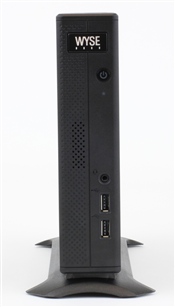Today marks a major breakthrough in cloud client computing; Dell is now shipping the industry’s first quad core, Windows Embedded 8 Standard thin clients. The most powerful machines of their kind, the Dell Wyse D class and Z class thin client platforms combine the security, low power, and high performance of Dell Cloud Client Computing’s endpoints with the latest advances of the Windows Embedded 8 platform for a more robust virtual desktop environment.
 The D and Z class thin clients join Dell Cloud Client Computing’s portfolio of offerings designed to simplify IT. With Dell desktop virtualization solutions, IT departments gain peace of mind knowing that corporate data is controlled in the data center and spend less time worrying about administrative tasks with centralized management of desktops. The operating system gives IT departments the flexibility to customize user configurations and set policies at the user level from the cloud to simplify the management of the thin client devices. This enables organizations to modernize their IT infrastructure without needing additional IT resources.
The D and Z class thin clients join Dell Cloud Client Computing’s portfolio of offerings designed to simplify IT. With Dell desktop virtualization solutions, IT departments gain peace of mind knowing that corporate data is controlled in the data center and spend less time worrying about administrative tasks with centralized management of desktops. The operating system gives IT departments the flexibility to customize user configurations and set policies at the user level from the cloud to simplify the management of the thin client devices. This enables organizations to modernize their IT infrastructure without needing additional IT resources.
As the only thin clients that combine a 64-bit Windows Embedded OS with Secure Boot, the D and Z class stand alone in thin client performance and security, with a powerful OS that keeps pace with the speed of business. Equally important, the D and Z class thin clients are equipped with Secure Boot, a security feature that protects corporate devices from malicious or rogue programs or drivers that have not been signed. This further enhances the performance and security value proposition the Dell Wyse thin clients brings to the enterprise.
To streamline IT management even more, Dell Wyse thin clients based on Windows Embedded 8 Standard also incorporate a configurable version of Microsoft Windows Defender to secure thin clients against malware. With Dell Wyse Windows Embedded 8 Standard-based thin clients, users can customize their own start screen, start menu toolbar, and desktop shortcuts for even greater ease and command of how they access key resources from the desktop. The new D and Z class thin clients ship with remote protocols including Microsoft Remote Desktop Protocol 8.0 with RemoteFX, Citrix Receiver, Dell vWorkspace Connector, and VMware Horizon View Client.
Based on Windows Embedded 8 Standard, the D class and Z class do not compromise on user experience in order to gain the IT efficiencies of desktop virtualization. The thin clients’ powerful quad-core AMD integrated graphics processing units (GPUs) work at the speed of business and deliver users a high fidelity experience. Users benefit from the Windows 8 features including multi-touch, modern UI and gestures and access to Windows 8 apps for an immersive multimedia experience with all the essential tools for workplace productivity. When users are not in a VDI session, the Windows Embedded 8 Standard platform delivers a unified experience and gives users local access to content when they do not have access to the cloud.
D class and Z class thin clients are poised to change the game for industries have relied on the security, affordability and flexibility of virtual computing to get business done. Dell’s quad-core devices have the power to handle demanding software and productivity applications and display high definition graphics and videos. With various hardware options, optional disk and memory, and support for up to eight displays, the use case is expanded even further.
For example, in a healthcare environment, the D class and Z class thin clients give providers the assurance that patient data remains HIPAA compliant, but still delivers doctors and nurses the vivid graphics they need to care for their patients. Financial services customers also benefit from the high-fidelity virtual desktop experience provided by Dell’s quad core thin clients and the multi-touch features offer the retail industry a secure, manageable and affordable option for point-of-service, digital signage and interactive kiosk applications.
Only Dell offers this combination of high security and performance giving the enterprise a win-win solution for desktop virtualization environments.